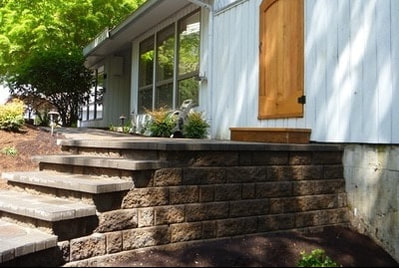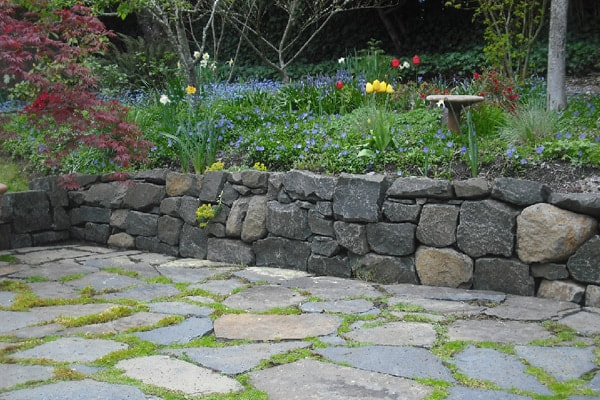|
There are many options when it comes to adding hardscape features to your landscape. This blog series focuses on a different landscape feature each time and will help you determine the best materials to use for each type of project. In this second blog of the series, we will explore two of the most popular options for retaining walls. This article should help you make a more informed choice when you are ready to pick your materials.
Blocks When it comes to building a retaining wall, the most common 'go to' material used is pre-formed blocks. Blocks offer several advantages including lower cost, uniform sizing making planning easy, a variety of colors and finishes, and quicker installation. Maintenance of a retaining wall made from blocks is fairly minimal — you can choose to add a sealant if you'd like and you also add capstones to create seating for lower walls. The only drawback is that while a block wall provides that 'clean' look, it can also be a bit boring if you're into walls with character. Blocks are readily available and can help you get your retaining wall finished and checked off the 'to do' list in short order. Natural Stone Natural stone is another common material for building retaining walls. While natural stone can be a tad more expensive, it's durability and character are second to none. Natural stone, when used for retaining walls, allows for interesting spaces between pieces where you can add moss, succulents, or other crevice-loving plants. Like blocks, you can choose stone in a variety of colors and textures, and you can also arrange them in ways possible to allow for seating. Working with natural stone can be more involved, requiring more planning, but the result is a beautiful, one-of-a-kind wall sure to be a gem in your landscape. Of course, there are other materials you can consider for your retaining wall, and we're happy to explore those options with you. Our team of experts can help weight the pros and cons of each option and help you choose the material that's right for your application. For more information about retaining walls, please give us a call. The professionals at Graham Landscape & Design are here to make sure you have the tools to make the best decision for your home. 541-729-8029
4 Comments
1/13/2022 09:42:03 pm
Thanks for sharing a great piece of information. Keep sharing such useful blogs in the future too.
Reply
8/10/2022 04:53:36 am
Thank you for sharing this informative article of yours. I hope there's a lot of people can read this article and be guided.
Reply
8/23/2022 08:10:19 pm
It helped when you said that blocks are used to lower the cost of the project but provides durability. The other day, my godfather told us that he was planning to replace their retaining walls because it is causing soil erosion in their garden, and he asked if I had any idea what would be the best option to resolve it. I'm thankful for this helpful article, I'll tell him that consulting a well-known retaining wall service can provide details about the process.
Reply
11/25/2022 06:17:57 pm
I'm glad that you talked that you should consider the materials to be used for your retaining wall function. A couple of days ago, my father mentioned that he was planning to replace their current retaining walls because it is causing soil erosion in their garden. He asked if I had any idea what would be the best option to consider. I'm grateful for this informative article, I'll tell him that consulting a well-known retaining wall service can provide information about the process.
Reply
Your comment will be posted after it is approved.
Leave a Reply. |
OUR BLOG
Check here to see what we've been up to! Categories
All
|
|
|
Copyright © Graham Landscape Maintenance & Design LLC in Eugene Oregon. All rights reserved.
LCB # 8920 541-729-8029 34024 Old Willamette Hwy S., Eugene, OR 97405
Offering Landscape Design and Maintenance in Albany, Coburg, Corvallis, Cottage Grove, Eugene, Junction City, Roseburg, Springfield, Veneta and Surrounding Areas
LCB # 8920 541-729-8029 34024 Old Willamette Hwy S., Eugene, OR 97405
Offering Landscape Design and Maintenance in Albany, Coburg, Corvallis, Cottage Grove, Eugene, Junction City, Roseburg, Springfield, Veneta and Surrounding Areas


 RSS Feed
RSS Feed
